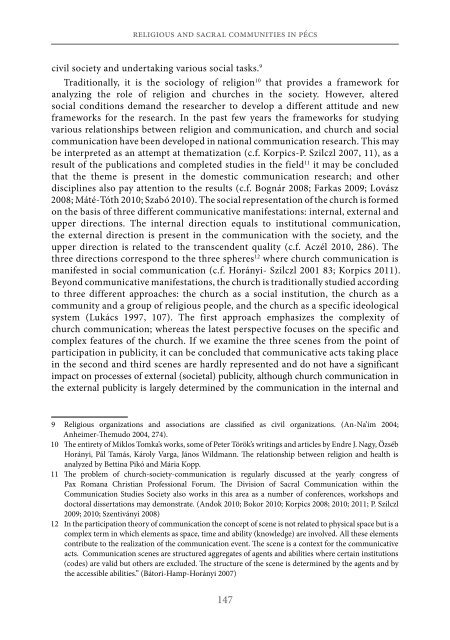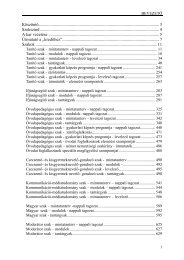ACTA SZEKSZARDIENSIUM - Pécsi Tudományegyetem Illyés Gyula ...
ACTA SZEKSZARDIENSIUM - Pécsi Tudományegyetem Illyés Gyula ...
ACTA SZEKSZARDIENSIUM - Pécsi Tudományegyetem Illyés Gyula ...
Create successful ePaper yourself
Turn your PDF publications into a flip-book with our unique Google optimized e-Paper software.
eligious and sacral communities in pécs<br />
civil society and undertaking various social tasks. 9<br />
Traditionally, it is the sociology of religion10 that provides a framework for<br />
analyzing the role of religion and churches in the society. However, altered<br />
social conditions demand the researcher to develop a different attitude and new<br />
frameworks for the research. In the past few years the frameworks for studying<br />
various relationships between religion and communication, and church and social<br />
communication have been developed in national communication research. This may<br />
be interpreted as an attempt at thematization (c.f. Korpics-P. Szilczl 2007, 11), as a<br />
result of the publications and completed studies in the field11 it may be concluded<br />
that the theme is present in the domestic communication research; and other<br />
disciplines also pay attention to the results (c.f. Bognár 2008; Farkas 2009; Lovász<br />
2008; Máté-Tóth 2010; Szabó 2010). The social representation of the church is formed<br />
on the basis of three different communicative manifestations: internal, external and<br />
upper directions. The internal direction equals to institutional communication,<br />
the external direction is present in the communication with the society, and the<br />
upper direction is related to the transcendent quality (c.f. Aczél 2010, 286). The<br />
three directions correspond to the three spheres12 where church communication is<br />
manifested in social communication (c.f. Horányi- Szilczl 2001 83; Korpics 2011).<br />
Beyond communicative manifestations, the church is traditionally studied according<br />
to three different approaches: the church as a social institution, the church as a<br />
community and a group of religious people, and the church as a specific ideological<br />
system (Lukács 1997, 107). The first approach emphasizes the complexity of<br />
church communication; whereas the latest perspective focuses on the specific and<br />
complex features of the church. If we examine the three scenes from the point of<br />
participation in publicity, it can be concluded that communicative acts taking place<br />
in the second and third scenes are hardly represented and do not have a significant<br />
impact on processes of external (societal) publicity, although church communication in<br />
the external publicity is largely determined by the communication in the internal and<br />
9 Religious organizations and associations are classified as civil organizations. (An-Na’im 2004;<br />
Anheimer-Themudo 2004, 274).<br />
10 The entirety of Miklos Tomka’s works, some of Peter Török’s writings and articles by Endre J. Nagy, Özséb<br />
Horányi, Pál Tamás, Károly Varga, János Wildmann. The relationship between religion and health is<br />
analyzed by Bettina Pikó and Mária Kopp.<br />
11 The problem of church-society-communication is regularly discussed at the yearly congress of<br />
Pax Romana Christian Professional Forum. The Division of Sacral Communication within the<br />
Communication Studies Society also works in this area as a number of conferences, workshops and<br />
doctoral dissertations may demonstrate. (Andok 2010; Bokor 2010; Korpics 2008; 2010; 2011; P. Szilczl<br />
2009; 2010; Szentiványi 2008)<br />
12 In the participation theory of communication the concept of scene is not related to physical space but is a<br />
complex term in which elements as space, time and ability (knowledge) are involved. All these elements<br />
contribute to the realization of the communication event. The scene is a context for the communicative<br />
acts. Communication scenes are structured aggregates of agents and abilities where certain institutions<br />
(codes) are valid but others are excluded. The structure of the scene is determined by the agents and by<br />
the accessible abilities.” (Bátori-Hamp-Horányi 2007)<br />
147




